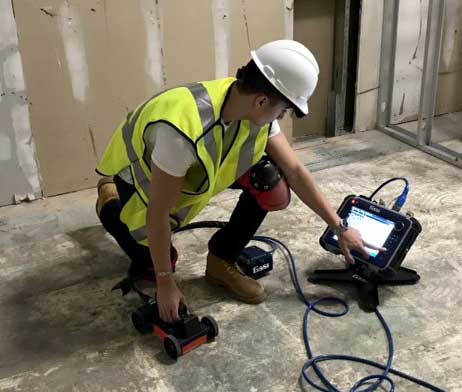RainierGPR Concrete Scanning: Ingenious Solutions for Complicated Jobs
RainierGPR Concrete Scanning: Ingenious Solutions for Complicated Jobs
Blog Article
Discovering the Secret Advantages of Concrete Scanning in Construction Projects
In the realm of modern building and construction methods, the utilization of concrete scanning modern technology has arised as an essential device for guaranteeing task efficiency and architectural integrity. From boosting safety procedures to accurately detecting utilities concealed underneath the surface, the benefits of concrete scanning are multifaceted. RainierGPR Concrete Scanning.
Improved Security Steps
Using innovative concrete scanning technology improves precaution on building and construction sites by supplying exact detection of possible threats concealed under the surface area. This modern technology allows building teams to identify rebar, channels, post-tension cords, and other blockages prior to excavation or exploration, dramatically reducing the threat of accidents. By identifying these components specifically, employees can prevent harmful vital structural components, thus preventing injuries, delays, and pricey fixings.
Additionally, concrete scanning plays a crucial role in ensuring the honesty of existing frameworks during remodellings or expansions. By discovering weaknesses, gaps, or deterioration within concrete components, designers can deal with these issues proactively, boosting the general security and longevity of the structure. This positive technique not only minimizes the danger of structural failings however likewise reduces the potential for accidents brought on by unexpected structural deficiencies.
Essentially, the application of concrete scanning innovation works as a positive precaution that safeguards both construction employees and the structural honesty of buildings, inevitably contributing to the general success and efficiency of building projects. - RainierGPR Concrete Scanning
Accurate Detection of Energies
Concrete scanning innovation facilitates exact recognition of underground utilities, enhancing building website safety and effectiveness. Exact discovery of utilities is vital in construction projects to stop costly damages, job hold-ups, and most importantly, make sure the safety of workers and the general public. By making use of advanced scanning innovations such as ground-penetrating radar (GPR) and electro-magnetic induction, construction teams can draw up the area of buried pipelines, wires, and other utilities with high degrees of precision.

Time and Cost Effectiveness

Concrete scanning innovation makes it possible for building groups to precisely situate rebar, post-tension cables, and other ingrained objects within concrete structures. This specific information assists in staying clear of costly errors such as unintended damage to vital aspects during exploration, reducing, or coring activities. Furthermore, by determining possible risks in this post advance, the need for expensive repairs or revamp due to damages can be lessened, leading to cost financial savings for the task.

Furthermore, the capability to promptly and properly detect utilities below the surface without causing any type of damage not only saves time however likewise stops expensive disturbances to existing framework. On the whole, the moment and price performance advantages of concrete scanning make it a very useful device for boosting building and construction task monitoring and implementation.
Conservation of Architectural Stability
Protecting the structural stability of buildings and infrastructure is critical in guaranteeing long-lasting stability and security. Concrete scanning plays a vital function in this conservation procedure by enabling building and construction specialists to recognize possible risks to the structural honesty of a structure or facilities before they rise right into major concerns. With making use of advanced scanning modern technologies such as ground-penetrating radar (GPR) and electro-magnetic induction, construction groups can non-invasively examine the condition of concrete structures, situate rebar, post-tension cords, and other ingrained aspects, and identify any kind of spaces, get more cracks, or damage within the concrete.
Improved Task Planning
In order to ensure the effective execution of building and construction jobs, meticulous focus to detail and extensive preparation are necessary components that stem from a thorough understanding of the structural problems identified via concrete scanning. Improved task planning, promoted by concrete scanning, allows building teams to preemptively attend to potential difficulties, allocate resources extra effectively, and establish sensible timelines. By accurately recognizing the location of rebar, post-tension wires, and various other ingrained items within concrete frameworks, project managers can create more exact construction plans that decrease the danger of costly errors or delays. In addition, the information obtained from concrete scanning allows stakeholders to make enlightened choices regarding architectural adjustments, renovations, or expansions, causing smoother job changes and boosted total project outcomes. Ultimately, incorporating concrete scanning into the project planning phase enhances sychronisation among employee, promotes positive analytical, and adds to the successful shipment of building jobs within budget and schedule constraints.
Conclusion
Finally, concrete scanning uses countless benefits in construction projects. By enhancing precaution, precisely finding energies, boosting time and price effectiveness, protecting structural stability, and aiding in task planning, concrete scanning proves to be an important tool for effective job implementation. Its capability to mitigate threats, boost efficiency, and make certain job integrity makes it an important asset for building and construction professionals.
In the world of contemporary construction techniques, the use of concrete scanning technology has actually arised as a critical device for guaranteeing job efficiency and architectural stability.Concrete scanning modern technology enables building teams to properly locate rebar, post-tension wires, and other ingrained objects within concrete frameworks. Through the use of innovative scanning technologies such as ground-penetrating radar (GPR) and electro-magnetic induction, building and construction teams can non-invasively assess the condition of concrete frameworks, locate rebar, post-tension cords, and other ingrained elements, and determine any kind of voids, fractures, or damage within the concrete.
In order to make find out certain the successful execution of building tasks, thorough focus to information and extensive planning are vital components that stem from an extensive understanding of the structural conditions determined via concrete scanning. Ultimately, incorporating concrete scanning into the project planning stage boosts control amongst group participants, promotes positive analytical, and contributes to the successful delivery of construction projects within budget and schedule constraints.
Report this page